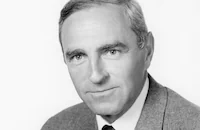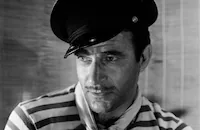Bandido

Brief Synopsis
Cast & Crew
Richard Fleischer
Robert Mitchum
Ursula Thiess
Gilbert Roland
Zachary Scott
Rodolfo Acosta
Film Details
Technical Specs

Synopsis
In 1916, American arms smuggler Kennedy and his wife Lisa enter Mexico during the civil war while everyone else is trying to get out. They are met by Gen. Lorenzo and his aide Gunther, who take them to their hotel for a meeting. There, another American gunrunner named Wilson meets with his seedy informant, McGee. McGee tells Wilson about Kennedy's plans to sell munitions to the Mexican army, known as the Regulares, to help them destroy the rebel forces led by José Escobar at Villa Hidalgo. When Wilson overhears an argument between Lisa and Kennedy, who expects his wife to charm his clients, Wilson suggests Lisa visit one of the nearby divorce shops, and she rebuffs him without a word. Wilson travels to embattled Hidalgo and evades the gunfire to arrive safely at a hotel positioned at the front. When the Regulares set up guns outside the hotel, Wilson tosses several grenades off his balcony. With his help, the rebels push back the Regulares and hail Wilson as their hero. Escobar later kicks in the door to Wilson's room by way of introduction, and confronts him. Wilson, who is called "alarcon," or scorpion, by the rebels, offers Escobar free munitions without which they will lose, in exchange for Escobar's help in stealing Kennedy's supply, which they would then split: half for Escobar's army, and half for Wilson to sell for profit. Escobar rejects his suggestion until many of his men are wounded during another exhaustive battle. Wilson, Escobar and his troops then mount an attack against the train carrying Kennedy, Lisa and Gunther. Gunther escapes to inform Lorenzo about Kennedy's plan to trick Wilson into believing that the arms are housed at Kennedy's fishing lodge. After being captured by Wilson, Kennedy lies that the munitions are at his lodge. Surmising that Kennedy uses Lisa as a pawn rather than a wife, Wilson sends Lisa to the lodge with Escobar's lieutenant, Gonzalez, to look for the munitions. When a distrustful Escobar tells Wilson that Gonzalez has been instructed to kill Lisa if there are no weapons, Wilson slips off the train unnoticed. At the lodge he discovers that Kennedy lied and warns Lisa about the threat to her life. In order to save her, Wilson sends Gonzalez back to Escobar with the promise that he will carry out Escobar's order. Instead Wilson falls in love with Lisa and takes her to a nearby fishing village, where they are captured by Gunther. After Wilson escapes with an attacking rebel force, Gunther takes Lisa to see Lorenzo at his headquarters, where she offers to ascertain the location of the weapons from her husband. Meanwhile, Escobar imprisons both Wilson and Kennedy for their betrayals, and prepares to execute them. A fearful Kennedy then admits to Wilson that the armaments are cached at Playa Blanca. Armed with this information and a couple of grenades, Wilson escapes with Kennedy, who is shot in the back by Escobar's men as they flee. When the Regulares draw near, Escobar calls off the search for the fugitives. Wilson takes Kennedy to a nearby church where a priest extracts the bullet from Kennedy's wound. Lisa finds them there and reveals to Wilson that Lorenzo and his forces await her information, and that she hopes to save Wilson's life. Bound by love as well as self-sacrifice, Lisa gives Wilson her horse so that he can escape safely. However, Kennedy has recovered enough to steal the gun from Lisa's purse and hold them at gunpoint outside. Escobar, who is lurking nearby, hears Kennedy say that Wilson intends to give the weapons to the rebels, and shoots and kills Kennedy. He and Wilson renew their friendship and ride to Playa Blanca, while Lisa tells Lorenzo and Gunther about her failure to uncover the location of the weapons. At Playa Blanca, Escobar and Wilson find the barges filled with munitions and fend off attacks by the Regulares. To prevent the rebel troops from being ambushed, Wilson and Escobar explode one of the barges, allowing the rebels to successfully rout the Regulares. Later, a celebratory Escobar invites Wilson to remain with his troops and fight, but Wilson's heart is with Lisa, whom he has arranged to meet down south.

Director

Richard Fleischer
Cast

Robert Mitchum
Ursula Thiess

Gilbert Roland

Zachary Scott
Rodolfo Acosta

José Torvay

Henry Brandon

Douglas Fowley
Víctor Junco
Alfonso Sánchez Tello
Arturo Manrique
José ángel Espinosa
Margarito Luna
Miguel Inclán
José Muñoz
Manuel Sánchez Navarro
Antonio Sandoval
Alberto Pedret
Crew
Jack Barnett
Layne Britton
John Burch
John Burch
José Carles
Mario Cisneros
Roscoe S. Cline
Earl Felton
Wayne Fury
Robert Golden
Lupe González
Ana Guerrero
Virgil Hart
Robert L. Jacks
Ernest Laszlo
Charles Martel
Robert Mitchum
Oscar Rodríguez
Ramón Rodríguez
Alfonso Sánchez Tello
Luis Sánchez Tello
Raphael J. Sevilla
Jack Martin Smith
Max Steiner
Max Steiner
Salvador Topete
Manuel Urqueza Gómez
Carlos Villatoro

Film Details
Technical Specs

Articles
Bandido
The script for Bandido had its origin in an idea by writer Earl Felton, who had been brought in to rewrite the ending of the Howard Hughes-produced His Kind of Woman (1951) at RKO. A victim of childhood polio, Felton got around on crutches, his legs locked into metal braces, but he managed to keep up with Mitchum on bar crawls through Hollywood and became a trusted confidante. Picking up on Mitchum's image of himself as "a soldier of fortune," Felton crafted a treatment set during Mexico's 1916 revolution, with Mitchum as a gringo adventurer who befriends guerilla leader Pancho Villa while an American movie company gets it all on film. Enthusiasm within the industry ran high for Felton's treatment and Richard Fleischer (who had helmed the reshoots on His Kind of Woman) agreed to direct.
While Mitchum and Fleischer toiled on other projects, Felton banged out the script, which bore the title Bandido!. Unfortunately, both Mitchum and his director hated the finished result, which rejected the planned meta-western in favor of a flat shoot-em-up and replaced the legendary Pancho Villa with a vaguely Villaesque surrogate. Although Fleischer tried to back out of the deal, the threat of litigation from United Artists brought him back. By way of revenge, Fleischer commanded Felton to travel with the crew to Mexico and be available for rewrites during principal photography. Traveling south with Mitchum, Felton and Fleischer were Zachary Scott (cast as Mitchum's rival in the armament business) and Gilbert Roland (as the Pancho Villa stand-in Colonel Escobar), while German actress Ursula Thiess (then the wife of actor Robert Taylor) was brought along to be Mitchum's leading lady. Location shooting was grabbed in coastal Acapulco as well as inland in Cuernavaca and Tepoztlán (with the ranks of extras filled out by men who had fought with and against Pancho Villa forty years earlier) while interiors were shot at Mexico City's Churubusco Studios. As Mitchum had a percentage of Bandido!'s profits, his legendary thirst for mischief was largely held in check. Trouble did rear its head in the aftermath of a bar fight, where Mitchum's stand-in, Tim Wallace, allegedly decked a senorita who was the mistress of a Mexican policeman. When local gossip marked Mitchum as the assailant, the actor fled his hotel to seek refuge in Richard Fleischer's rented posada until the situation blew over.
If Earl Felton's script for Bandido! was nothing to write home about the production itself was complicated from a logistical standpoint, involving the movement of hundreds of extras in coordination with special effects explosions and human and animal stunt work. Injuries sustained by the cast included shredded skin for Mitchum (who did most of his own stunts), a dislocated knee for Zachary Scott and cuts and bruises suffered by Ursula Thiess when she was thrown off of her feet during a scene shot aboard a moving train. Another scare came when a car in which Mitchum and Felton were passengers was stopped in the Zona Rosa by the Mexican police. A search of the trunk netted a parcel of marijuana, at which point Mitchum was detained by the authorities until a fine of $10,000 was paid by Bandido! production manager John Burch. The cast and crew left Mexico the next morning and, according to Fleischer, "no one was late for the plane."
In the end, Mitchum and Fleischer were able to custom Bandido! more toward their liking and audiences responded more enthusiastically to Mitchum's return to devil-may-care heroics. The combination of Richard Fleischer's muscular direction and Ernest Laszlo's widescreen cinematography was another plus, although the latter was for years impossible to appreciate in faded, center-framed television broadcasts. Over fifty years since the production wrapped and ten years after Mitchum's death in 1997, the time has come for an honest reappraisal of a film that Mitchum biographer Lee Server considers "one of his most personal works... bringing his gaudiest daydreams to life and allowing audiences, if they so desired, to share in the fun."
Producer: Robert L. Jacks
Director: Richard Fleischer
Screenplay: Earl Felton
Cinematography: Ernest Laszlo
Film Editing: Robert Golden
Art Direction: Jack Martin Smith
Music: Max Steiner
Cast: Robert Mitchum (Wilson), Ursula Thiess (Lisa Kennedy), Gilbert Roland (Col. Escobar), Zachary Scott (Kennedy), Rodolfo Acosta (Sebastian), Jose Torvay (Gonzalez).
C-92m.
by Richard Harland Smith
Sources:
Robert Mitchum: A Biography by George Eells
Robert Mitchum: "Baby, I Don't Care" by Lee Server
The United Artists Story
Ephraim Katz Film Encyclopedia
The BFI Companion to the Western Edward Buscombe, ed.
Western Films: A Complete Guide by Brian Garfield

Bandido
Quotes
Trivia
The film was shot on many of the actual battle sites of the 1916 Mexican revolution, the period during which this film is set. Many of the older Mexicans hired as extras in the film were former soldiers of Pancho Villa and others were former government troops who fought them.
Notes
This film was shot on location in the following Mexican locales: Cuernavaca, the Dominican Cathedral in Tepetzlan, Palo Balero Falls, Yaltapec and the Cocoyac Hacienda, according to the pressbook. Contemporary news items note that the film was a collaboration between Robert Mitchum's independent production company DRM Productions and Robert L. Jacks Productions. According to a June 16, 1955 Variety news item, Bandido marked Mitchum's first producing effort.

Miscellaneous Notes
Released in United States Fall September 1956
CinemaScope
Released in United States Fall September 1956














